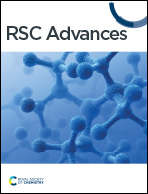Polyacetylenes with (hetero)aryl-, styryl-, and amino-phenothiazinyl sidechains: synthesis and photophysics†
Abstract
A novel generation of 7-aryl phenothiazinyl substituted polyacetylenes is readily accessible via controlled rhodium-catalyzed polymerization of the corresponding 3-ethynyl 7-aryl phenothiazines. The monomers are synthesized by Suzuki coupling, Heck coupling, or Buchwald–Hartwig amination, and Bestmann–Ohira reaction. This allows for the introduction of electron donating and releasing substituents with different ligation patterns. The obtained polymers display narrow molecular weight distributions, with very few exceptions, and are soluble in many organic solvents. The photophysical properties of novel monosubstituted polyacetylenes and corresponding monomers were compared. While the monomers exhibit strong emission in solution with quantum yields of up to 0.84 only selected polymers are luminescent (Φf = 0.06) and display moderate Stokes shifts and positive emission solvatochromism.



 Please wait while we load your content...
Please wait while we load your content...